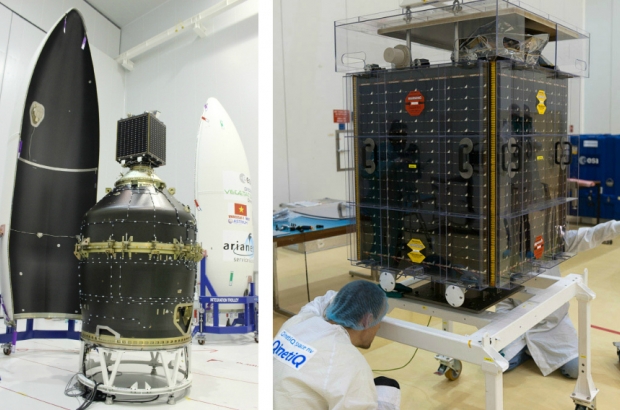- Daily & Weekly newsletters
- Buy & download The Bulletin
- Comment on our articles
A bridge to space: QinetiQ sends satellites into orbit
The launch of the satellite Proba-V a month ago, and its successful positioning in low orbit, brings us back to Kruibeke. Here, on the left bank of the river Scheldt, lie the European headquarters of QinetiQ Space – the company that built Proba-V. For me, it’s a reunion of sorts, because I was here five years ago, watching engineers add the finishing touches to Proba-2, the precursor of Proba-V that’s been swirling around the Earth since 2009.
At the time, the company still carried the name Verhaert Space, after the founder, Paul Verhaert, who founded his own product development company back in 1969. Since 2005, the company’s space division has been owned by the QinetiQ group. “QinetiQ is a British multinational active in the field of security and defence,” explains Jo Bermyn, marketing director at QinetiQ Space. “But our entire company is still a Belgian company based in Kruibeke. In fact, another division of QinetiQ Space, based in Farnborough in the UK, falls directly under our supervision.”
The absence of gravity
QinetiQ Space kick-started its space activities in 1983, when the company signed its first assignment with the European Space Agency (ESA). “Our task was to develop and build instruments for scientific research in the field of microgravity,” says Bermyn. “Our instruments were used in several manned space stations, like Spacelab, Mir and today the International Space Station. So when we saw astronauts like Frank De Winne or Dirk Frimout performing tests in space, they were using our experimental setup.”
Today, microgravity is still a major field in space-related scientific research. With future space missions that aim to take humans to Mars in mind, one of the key obstacles of such a long journey remains the absence of gravity. Scientists still don’t know exactly how much harm this causes to the human body – and how to avoid it.
QinetiQ Space is still developing scientific instruments for space missions, but since the beginning of the 1990s, it has been converting itself from a supplier of subsystems into a provider of complete so-called “end-to-end space systems”. It’s an innovation strategy that was sparked by the ambition of the people at Kruibeke.
“Of course, with our limited capacity at that time – we had only 30 employees in 1991 – there was little chance that we could do this entirely on our own," says Bermyn. "Luckily for us, the ESA decided at that time to start a new technology demonstration programme, focussing on the development of microsatellites. These are no bigger or heavier than a common washing machine and have a number of benefits: they’re light-weight and low-cost, they have a much higher degree of autonomy and can be built within a short time. With the support of the Belgian Science Policy Office to the ESA’s Technology Programme, we could win the contract to build the first microsatellite for the ESA.”
The company started building Proba-1 (Proba stands for Project for On-Board Autonomy) in 1998. Three years later, on 22 October, 2001, the local space industry experienced a historic day: The first through-and- through Belgian satellite was successfully put into orbit.
“The Proba-1 satellite was, in the first place, a technology demonstration mission,” explains Bermyn. “The aim was to demonstrate the possibility to perform a space mission without constant steering and supervision from the ground. That involves a huge saving in operational costs.”
Besides the technology to make satellites more autonomous, Proba-1 had two earth-observation instruments on board. “The technology demonstration period lasted for only a few months, but today Proba-1 is still flying around and making pictures of our planet on a daily basis.”
Proba-1’s success demanded a sequel. So, in 2009, Proba-2 was launched, with some demonstration technology on board. Bermyn says: “One of the new elements was the on-board computer, which is still the most powerful in any European satellite.” However, “powerful” is perhaps not the right word. “You might compare it to an Intel 80386 processor," says Bermyn. "Our laptops and smartphones are several times more powerful, but I’ll bet they wouldn’t survive in space for long. These on-board computers have to be super-reliable – we can’t send somebody to space to repair them. They have to withstand extreme vibrations during launch and all sorts of electromagnetic radiation and extreme temperatures once in orbit. We say they must be ‘space-qualified’.”
The Earth-watcher
But even with this processor, Proba-2 is able to calculate entirely on its own what the best position is to take a picture – ordered from the ground. “The software calculates the best position, depending on the position of the sun. If there’s damage, the computer puts the satellite automatically into survival mode, where it can analyse and recover itself.”
Proba-2 also carries some observational instruments, to watch not the earth but the sun. “These instruments are used by the Belgian Royal Observatory in Brussels to deliver a daily space weather report to its customers. Companies who rely heavily on satellite communication want to know when solar wind and solar storms are coming.”
And so we end up with Proba-V, which was launched on May 7 and is in orbit 820km above the ground. The V stands for “vegetation”. “Proba-V is what we call a gap-filler mission," Bermyn explains. "The"goal is to ensure continuation of the vegetation instruments on the old Spot satellites. These two giant satellites have, for almost 10 years now, daily monitored and mapped the world’s vegetation, providing information on crop yields, droughts, desertification, deforestation… But the Spot satellite will retire at the end of this year. Until their successor, the Sentinel, arrives in 2015, Proba-V will take over the monitoring of the Earth’s vegetation.”
This article first appeared in Flanders Today


















